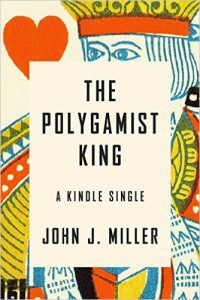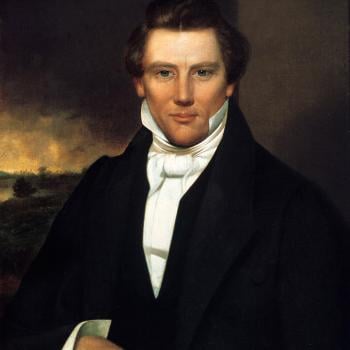Most people with only a passing acquaintance with the history of Mormonism presume that there was a simple transition to Brigham Young’s leadership after the June 1844 murder of Joseph Smith, Jr.
 In truth, Smith’s death precipitated several competing claims to leadership. A new “Kindle Single” authored by John J. Miller in The Polygamist King provides a concise and lively introduction to the least likely challenger: James J. Strang.
In truth, Smith’s death precipitated several competing claims to leadership. A new “Kindle Single” authored by John J. Miller in The Polygamist King provides a concise and lively introduction to the least likely challenger: James J. Strang.
At the time of Smith’s death, Strang was a thirty-one-year-old visionary and recent convert to Mormonism. Having long dreamt of greatness for himself, Strang sought to claim it given the vacuum of prophetic leadership. He produced a letter from Joseph Smith, dated nine days prior to his murder, appointing him (Strang) the church’s next leader. The members of the church’s Quorum of the Twelve Apostles, led by Brigham Young, read the text of Strang’s letter — a rather obvious forgery — and promptly excommunicated the upstart prophet.
Undeterred, Strang founded a community named Voree in southeastern Wisconsin and began gathering followers by preaching to church branches across the northeastern United States. He also proceeded to issue revelations and produced a set of buried ancient plates that served as the basis for his own effort at supernatural translation.
Young dismissed “Strangism” as “not worth the Skin of a Flea,” but for a time James Strang was a viable prophetic competitor. As the “Brighamites” struggled with mobs, sickness, and poverty in Nauvoo, some Latter-day Saints saw Voree as a refuge from their troubles. Strang forthrightly claimed to be Joseph’s successor; his plates, revelations, and visions provided some Mormons with a different sort of continuity than Young offered. Moreover, Strang at first opposed polygamy and thus attracted Mormons opposed to the practice. In short, Strang was everything Young was not: an obvious revelator, a translator of ancient texts, and — for the time being — a monogamist.
As his church grew, Strang attracted a number of high-profile converts to his cause, including Book of Mormon witness Martin Harris; former apostles William Smith (Joseph Smith’s brother), William McClellin, and John E. Page; and former Nauvoo Stake President William Marks. Strang drew perhaps five hundred Latter-day Saints to Voree, a significant movement within a church of perhaps thirty thousand adherents worldwide.
“Strangism” soon began to unravel, however. Strang chose unreliable men for some top positions, and he led his fractious church to Lake Michigan’s Beaver Island in 1847. Young’s success in leading his followers to the West, meanwhile, undercut part of Strang’s appeal.

In 1850, Strang had himself crowned king of his Beaver Island community (the move was based on the translation Strang called The Book of the Law of the Lord). Miller describes the ceremony thus:
Strang sat upon a throne made of wood, covered in cloth and stuffed with moss. He held a wooden scepter and wore a bright red robe trimmed with white, perhaps looking a bit like Santa Claus. An entourage of men with various church titles surrounded him, like dukes, earls, and barons at a court. At the climax of the coronation, [an associate] placed a crown of Strang’s head. Witnesses described it as a metal circlet, but it was in fact cast of heavy paper and decorated with tinsel. According to one account, the royal costume was a hodgepodge of Masonic garb. It was supposed to make Strang appear as a Jewish king from the Old Testament.
Imitating Smith in death as well as in life, Strang was murdered in 1856 by two disgruntled former members of his church.
Miller fills the short text of The Polygamist King with fascinating detail: the circumstances of Strang’s five marriages (he had his first plural wife dress as a man during one preaching mission), the multi-year tensions between the Strangites and other residents of Beaver Island, and the 1851 legal and military actions of the U.S. government against Strang. It’s a quick read, and an excellent introduction to a fascinating chapter in U.S. religious history.












